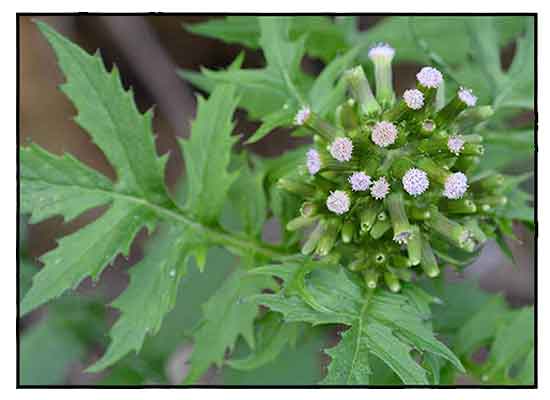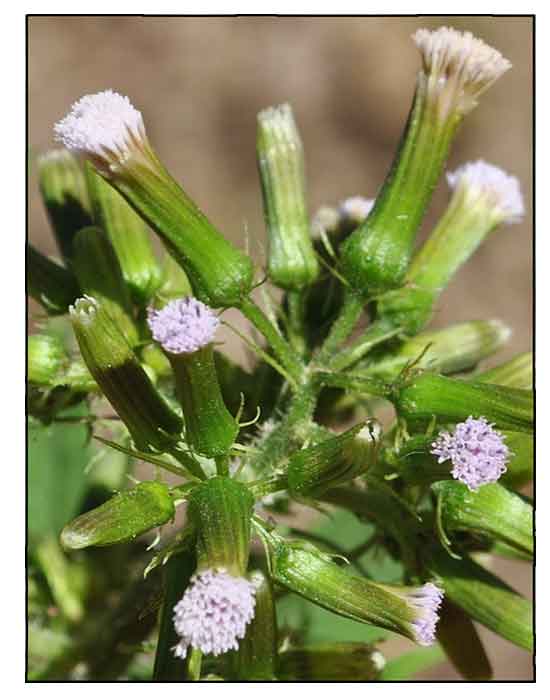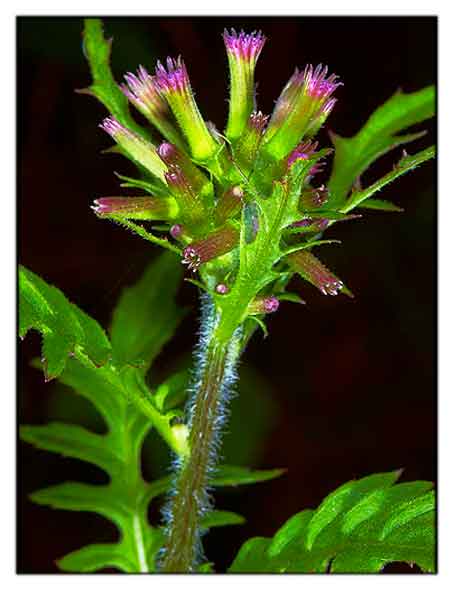 Gen info Gen info
- Erechtites is a genus of flowering plants in the daisy family, commonly known as fireweeds or burnweeds. Twenty-seven species are recognized by Plants of the World Online. (3)
-
Erechtites valerianifolius is a New World species of plants in the sunflower family, Asteraceae.
- Etymology / Taxon conflicts: The scientific name has a few conflicts.The genus Erechtites was orignally published by Rafinesque in 1817, based on an unnamed plant described by C.C. Robin. A second possible genus derivation is from ancient Greek Erechthonius, one of the of the kings of Attica (or possibly Neptune) in ancient Greek legends. Another problem arises from Latin grammaticval gender confusion, Erechtites has been traditionally treated as feminine, but the International Code of Botanical Nomenclature notes generic names ending in "-ites" are masculine. So, Erechtites valerianifolia, often used, is incorrect. Erechtites valerianifolia (grammatically incorrect) was described by Curt Joachim Sprengel, In 1838, Augustin Pyramus de Candolle circumscribed the species as valerianaefolia as a 'valid' binomial epithet, which is now regarded as an orthographical variant. (13)
Botany
• Erect annual, usually 1–1.5 m high, mostly glabrous except for cobwebby young growth. Lowest leaves with lamina ovate, 3–6 cm long, 2–3 cm wide, margins ± entire to toothed, petiole 5–15 mm long; upper leaves with lamina toothed, or pinnatisect to ± pinnate, mostly 5–20 cm long, 3–8 cm wide, petiole 0–50 mm long. Inflorescences ± corymbose, heads on stalks 0–10 mm long; heads c. 3 mm diam.; inner involucral bracts 10–14, c. 10 mm long, outer bracts c. 1 mm long. Achenes 2.5–3.5 mm long; pappus 8–10 mm long, white to mauve. (5)
 • Herbs, annual. Stems erect, 50-100 cm tall, simple or branched in upper part, striate, subglabrous. Leaves long petiolate; petiole narrowly winged; blade oblong to elliptic, both surfaces glabrous, pinnately veined, base cuneate, margin irregularly double serrate or pinnatipartite; lobes 12-16, lanceolate, acuminate, serrate to irregularly lobed, or rarely shallowly lobed, apex acute or acuminate; upper leaves similar to median leaves but smaller. Capitula numerous, erect or pendulous, in terminal and upper axillary dense corymbose panicles, ca. 10 × 3 mm, with linear bracteoles. Involucres cylindric-campanulate; phyllaries uniseriate, 12-14(-16), linear, 7-8 × 0.5-0.75 mm, glabrous or sparsely puberulent, 4- or 5-veined, apically acute or acuminate. Florets numerous, yellowish purplish; outer florets uni- or biseriate, corolla filiform, apically 5-denticulate; central florets minutely tubular-funnelform, 7-8 mm, rather longer and broader than outer ones, 5-denticulate, apically glandular thickened. Style branches with conical appendages. Achenes cylindric, 2.5-3.5 mm, glabrous or puberulent, 10-12-ribbed. Pappus reddish, as long as florets. (Flora of China) • Herbs, annual. Stems erect, 50-100 cm tall, simple or branched in upper part, striate, subglabrous. Leaves long petiolate; petiole narrowly winged; blade oblong to elliptic, both surfaces glabrous, pinnately veined, base cuneate, margin irregularly double serrate or pinnatipartite; lobes 12-16, lanceolate, acuminate, serrate to irregularly lobed, or rarely shallowly lobed, apex acute or acuminate; upper leaves similar to median leaves but smaller. Capitula numerous, erect or pendulous, in terminal and upper axillary dense corymbose panicles, ca. 10 × 3 mm, with linear bracteoles. Involucres cylindric-campanulate; phyllaries uniseriate, 12-14(-16), linear, 7-8 × 0.5-0.75 mm, glabrous or sparsely puberulent, 4- or 5-veined, apically acute or acuminate. Florets numerous, yellowish purplish; outer florets uni- or biseriate, corolla filiform, apically 5-denticulate; central florets minutely tubular-funnelform, 7-8 mm, rather longer and broader than outer ones, 5-denticulate, apically glandular thickened. Style branches with conical appendages. Achenes cylindric, 2.5-3.5 mm, glabrous or puberulent, 10-12-ribbed. Pappus reddish, as long as florets. (Flora of China)
Distribution
- Introduced to the Philippines; naturalized.
- Old clearings at low and medium elevation, often abundant. (2)
- Native to Argentina Northeast, Bolivia, Brazil Northeast, Brazil South, Brazil Southeast, Brazil West-Central, Colombia, Costa Rica, Dominican Republic, Ecuador, El Salvador, French Guiana, Guatemala, Guyana, Honduras, Leeward Is., Mexico Central, Mexico Gulf, Mexico Northeast, Mexico Southeast, Mexico Southwest, Nicaragua, Panamá, Paraguay, Peru, Puerto Rico, Uruguay, Venezuela, Venezuelan Antilles, Windward Is. (1)
- Now a widespread as weed from Mexico to Argentina; adventive as an aggressive weed in tropical Asia, the Pacific Islands, and northern Australia. (13)
 Constituents Constituents
- Essential oil of aerial parts was dominated by myrcene (47.8%) and α-pinene (30.2%) (see study below) (4)
- Study yielded total dietary fiber (3.7 g 100), ash (0.9 g 100), lipids (1.4 g 100), carbohydrates (2.9 g 100), proteins (1.3 g 100), caloric density (29.2 kcal 100), vitamin A (373.9 µg 100 RAE), K (561.2 mg 100), Ca (79.5 mg 100), and Fe (21.6 mg 100). (6)
- Phytochemical screening yielded alkaloids, flavonoids, steroids, with absence of terpenoid, tannin, and saponin. (8)
- Total phenolic content (TFC) of n-hexane, DCM, ethyl acetate, and methanol extracts were 10.64 mg GAE/g, 6.45 mg GAE/g, 6.69 mg GAE/g, and 3.23 mg GAE/g, respectively. Total flavonoid content (TFC) revealed 1.40 mg QE/g, 2.39 mg QE/g, 0.44 mg QE/g, and 0.11 mg QE/g, respectively. (see study below) (9)
- Study for nutrient composition yielded moisture of 83.5 g/100g, ash 2.8 g/100, fiber 3.8 g/100g, fat 0.2 g/100g, protein 1.8 g/100g, carbohydrate 2.5 g/100g, energy 19 kJ/100g, calcium 85.5 mg/100g, iron 2.2 mg/100g, potassium 525 mg/100g, magnesium 15.6 mg/100g. (10)
Properties
- Studies suggest mosquito larvicidal, antiplasmodial, cytotoxicity, antioxidant properties.
Parts used
Leaves, oil.
Uses
Edibility
- In West Java, leaves eaten as salad vegetable. (12)
- Used as vegetable for its protein, vitamin and mineral content.
- Flowering tops are eaten raw or steamed, served with rice.
Folkloric
- The Agusan Manobo use the plant for treatment of gas pain and flatulence. (10)
-
In Indonesia, plant used for treatment of fever, diarrhea, tonsillitis, wounds, and eczema.
- In Sulawesi, leaves use for
Used for minor injuries and wounds.
- In Malaysia, the Orang Asli use
cooked leaves for treatment of skin problems, fever, and tonsillitis. (11)
Studies
• Mosquito Larvicidal / Essential Oils: Study evaluated the bioactivity of extracts of E. valerianifolia. The essential oil showed good larvicidal activity against Ae. albopictus (24-h LC50 5.8 µg/ml), Ae. aegypti (24-LC50 12.5 µg/mL), and Cx. quinquefasciatus (24h LC50 40.7 µg/mL). (4)
• Antiplasmodial / Antibacterial / Antimicrobial / Anticancer: Study evaluated the bioactivity of various extracts (hexane, dichloromethane, ethyl acetate, and methanol) of E. valerianifolia. The extracts at maximum concentration of 1000 ppm were less active than positive control amoxicillin for antibacterial and ketoconazole for antifungal agents. Antiplasmodial screening against P. falciparum FCR3 activity showed IC50 of ethyl acetate extract of 117.122 µg/mL, considered the best among the extracts. Cytotoxicity study on MCF7, WiDr, and HeLa cells showed the extracts had good cytotoxicity with IC50s <30 µg/ml. (6)
• Antioxidant: Study evaluated various extracts of E. valerianifolia for antioxidant activity, total phenolic and flavonoid contents. Antioxidant activity of n-hexane, dichloromethane (DCM) ethyl acetate and methanol extracts by DPPH assay showed IC50s of 367.8, 139.52, 911.05 and 401.95 ppm, respectively, with DCM showing best antioxidant activity. The correlation between total phenolic/total flavonoid content and antioxidant test was less than 50%, indicating no direct/negative correlation between polyphenolic content and antioxidant activity. (see constituents above) (9)
Availability
Wild-crafted. |

![]()





 Constituents
Constituents